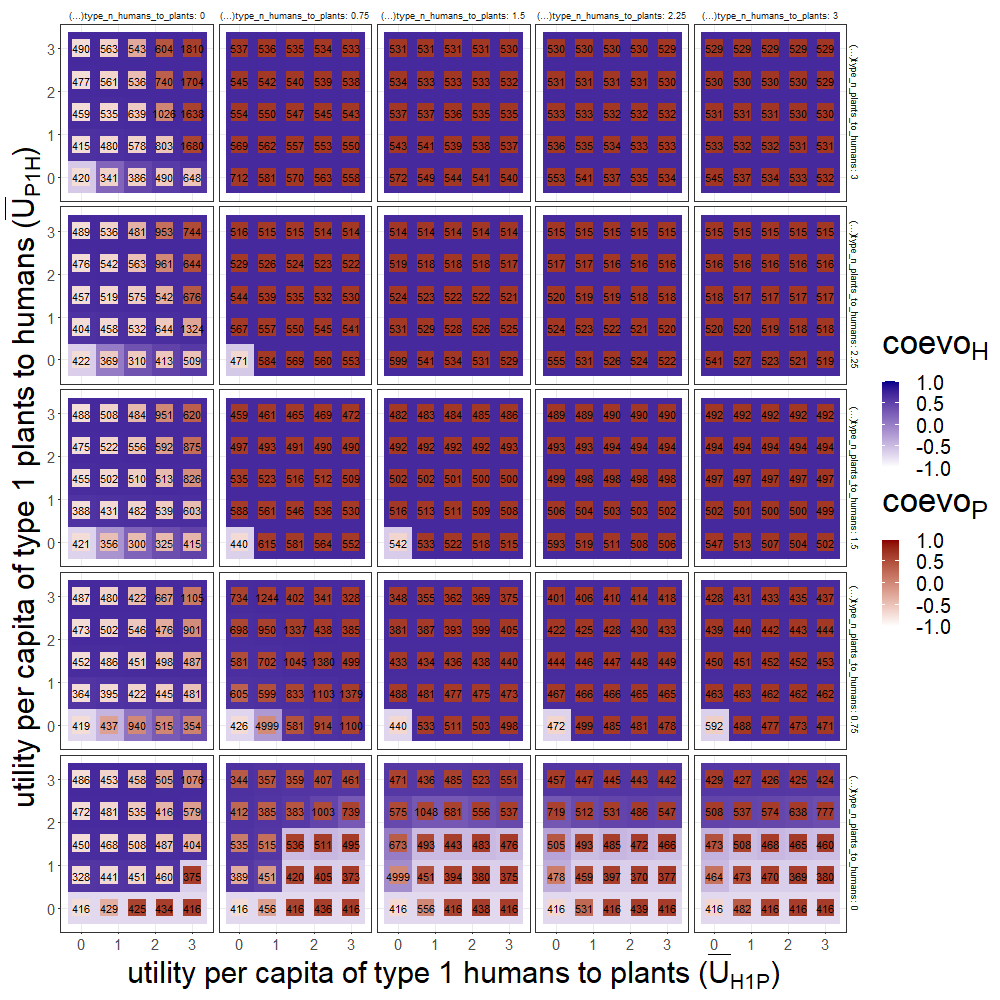4.2 Utility per capita between humans and plants (\(\bar{U}_{H_{1}P}\) x \(\bar{U}_{P_{1}H}\) x \(\bar{U}_{H_{n}P}\) x \(\bar{U}_{P_{n}H}\))
| parameter | value |
|---|---|
| initial_population_humans | 10 |
| initial_population_plants | 10 |
| number_types_humans | 30 |
| number_types_plants | 30 |
| undirected_variation_humans | 0.15 |
| undirected_variation_plants | 0.15 |
| intrinsic_growth_rate_humans | 0.04 |
| intrinsic_growth_rate_plants | 0.1 |
| utility_per_capita_type_n_plants_to_humans | 0 - 3 (sample = 5 ) |
| utility_per_capita_type_n_humans_to_plants | 0 - 3 (sample = 5 ) |
| utility_per_capita_type_1_plants_to_humans | 0 - 3 (sample = 5 ) |
| utility_per_capita_type_1_humans_to_plants | 0 - 3 (sample = 5 ) |
| utility_other_to_type_n_humans | 10 |
| utility_other_to_type_n_plants | 20 |
| utility_other_to_type_1_humans | 80 |
| utility_other_to_type_1_plants | 100 |
| max_area | 200 |
| max_iterations | 5000 |
| reltol_exponential | 6 |
| coevolution_threshold | 0.5 |
| humans | 74.5622526385153 - 616.122991274673 (sample = 611 ) |
| plants | 93.7854569646093 - 200 (sample = 222 ) |
| coevolution_coefficient_humans | -0.717940961994967 - 0.701298246126613 (sample = 611 ) |
| coevolution_coefficient_plants | -0.717941007482056 - 0.704797600572959 (sample = 625 ) |
| dependency_coefficient_humans | -1 - 0.947663005457465 (sample = 601 ) |
| dependency_coefficient_plants | -1 - 0.971381159245891 (sample = 602 ) |
| timing_humans | 0 - 219 (sample = 70 ) |
| timing_plants | 0 - 290 (sample = 85 ) |
| time_end | 300 - 4999 (sample = 248 ) |
| adaptativeCost.H | 0 |
| adaptativeCost.P | 0 |

Interpretation:
- Higher values of all four parameters facilitate coevolution; under the ‘default’ setting, a value around 1 is enough for all four parameters (intermediate values in this exploration).
- Coevolution is still possible if any single one of these parameters equal zero (first rows or first columns). Under this type of conditions, cultivation (blue) is more probable than domestication (red), and the latter is strongly dependent on a non-null \(\bar{U}_{H_{n}P}\).
- As a summary of possible end-states:
+ ‘Fast’ coevolution (red square in blue tile, small t): most cases when values are greater than 0.75.
+ Domestication without cultivation (red square in whitish tile): most cases when \(\bar{U}_{H_{n}P}>0.75\), \(\bar{U}_{H_{1}P}\geq 0.75\), \(\bar{U}_{P_{n}H}=0\), and \(\bar{U}_{P_{1}H}<2\).
+ Cultivation without domestication (whitish square in blue tile): most cases when \(\bar{U}_{H_{n}P} = 0\).